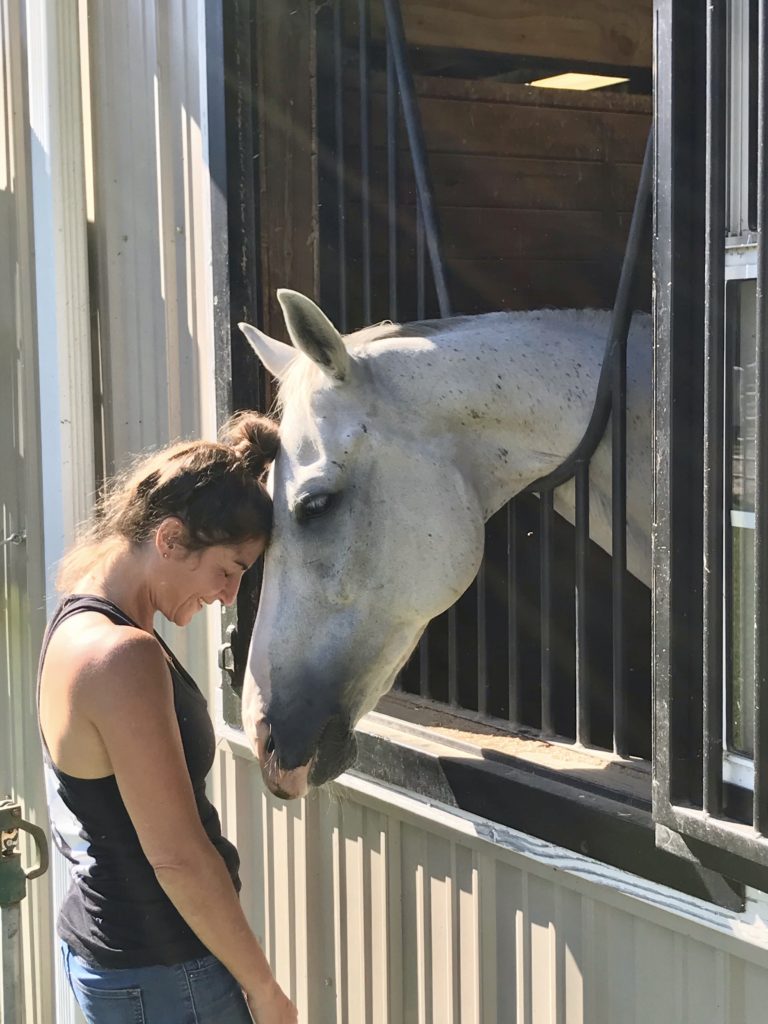By Nicole Rivard
When I first read that War Emblem had passed away at age 21 in March of 2020 at Old Friends, a thoroughbred retirement home, my first reaction was one of relief—relief that the racehorse I was enamored with and cheered on as he tried to capture the elusive Triple Crown in 2002 didn’t end up in the slaughter pipeline.
I remember the silence that fell over a record crowd of 103,222 spectators at Belmont Racetrack in New York when an ignored longshot named Sarava won the race and crushed everyone’s dreams of seeing history being made. There hadn’t been a Triple Crown winner since Affirmed in 1978.
War Emblem finished eighth after stumbling out of the starting gate. I remember trying to get as close to him as possible in the paddock area before the race. People were pushing against each other to get a glimpse of his great beauty—a glistening dark coat and white star beneath his forelock. For me it might as well have been Michael Jordan, Serena Williams or Peyton Manning.
Of course, now I’m ashamed to admit what a naïve view of horse racing I had back then; I thought it showcased the beauty and athleticism of horses and that these elite athletes live charmed lives.
I learned I was dead wrong and stopped attending races and supporting such an exploitive industry shortly after joining the staff of Friends of Animals in 2013. Not only did I become aware of the rampant drug use to enhance a horse’s peak performance, I also had the opportunity to interview Jo-Anne Normile, author of Saving Baby: How One Woman’s Love for a Racehorse Led to Her Redemption, and founder of two horse rescue organizations. No one knows the horrors of the racing industry better than Normile.

With a racetrack just a few miles from her home and being an avid follower of the Kentucky Derby and fan of Secretariat, Normile chose to breed two horses for racing. She left racing in disgust after tragedy struck her horse Baby and founded the first CANTER program in 1997. At the time it was the only rescue in the country that intercepted horses directly from their stalls at the track so they did not go to the onsite kill buyers. During Normile’s tenure with CANTER, the group was taking in more than 100 horses a year from just one racetrack.
Normile co-authored a study in 2012 that demonstrated that an amount equal to 70 percent of Thoroughbred foals on average died at slaughter from 2004 through 2010.
“People cannot demand change until they KNOW what needs to change. Horse slaughter is an economic necessity to the racing industry,” Normile told me. “Each stall at the track needs a horse capable of filling a race because they all make their living off these horses’ backs and broken legs through the bets placed on them. The more horses that race, the more money wagered and the more they all make. The injured and slow horses must be removed quickly and efficiently.
“To my knowledge, this $40-billion-dollar gambling industry has never lobbied to promote passage of any legislation that would ban the transport of America’s horses for slaughter for human consumption. They would not even lobby or promote passage of legislation to close horse slaughter plants when they still operated within the United States.”
While horses are no longer being slaughtered for human consumption in the United States (Bravo Packing is a slaughter plant that supplies cattle and horse meat, bones and hides to zoos), racehorses, like America’s wild horses, are always facing the threat of slaughter as long it continues to be legal to transport horses across our borders to Canada and Mexico or to any other country for the purpose of consumption.
However, New York legislators have given New York’s racehorses a reprieve. A state bill prohibiting the slaughter of racehorses passed the New York Assembly this summer and was sent to former Governor Andrew Cuomo.
Now New York’s new governor Kathy Hochul needs to be encouraged to sign the bill into law by Dec. 31. You can send her a message online or call her office at 1-518-474-8390.
The bill, which passed in the New York Senate in early February, prohibits the sale of any horse “known” to be a racehorse or racehorse breeding stock for the purposes of slaughter, which the bill defines as the “intentional killing” of a horse “for human or animal consumption.” Any individual who violates the law would be fined “not more than $1,000” for each horse, while any company or corporate entity would be fined “not more than $2,500” per horse. Violators would also face license revocation by the New York Gaming Commission. All fines collected under the law will go toward aftercare programs run by the New York State Breeding Fund.
Until public backlash puts the final nail in the coffin of the racing industry nationwide, this law is a step in the right direction. Susan Wagner, president of NY-based Equine Advocates, a sanctuary for horses, including former racehorses, agrees.
“While I wish the New York State horse slaughter ban protected all equines in the state from slaughter and not just Thoroughbreds and Standardbreds, it is still a major accomplishment as it will add to the number of states to pass anti-horse slaughter legislation, including California, Texas and Illinois,” Wagner said. “This is important as we continue to push for an effective federal ban.”
It’s also important to continue bringing the atrocities in horseracing to light just as it’s been done for circus animals and marine life imprisoned at places like SeaWorld.
I can’t unread what I read in Normile’s book, I can’t unsee a horse breaking down during a race, so I talk to my friends about how the few races they might see on TV with fancy hats and celebrities are far from the reality of the thousands of races they never see at lesser-known racetracks throughout the country.
From 2018-19 there were more than three dozen on-track horse deaths at Santa Anita Park in California. In 2020, 29 trainers, veterinarians and pharmacists were indicted on federal charges in a horse doping ring.
It is not a sport—it’s a gambling enterprise and if people stop betting, the industry will die instead of its horses that are forced to participate.
I’m lucky that I get to provide care for two former racehorses, Jasper and Shadow, who call the barn where I work on Sundays home.
Jasper is serious and proud, but Shadow’s more of a class clown. He likes to dunk his TNT in his water bucket like an Oreo cookie and it gets all over his white coat. He smacks his lips together for treats and runs his pink muzzle back and forth along the bars of his stall doors making music when it’s feeding time.
I’ve always felt a special connection with them. Sometimes I find myself wondering what they’ve been through. But mostly I just like to be present in the moment with them, grateful they survived an industry that many other horses don’t.

